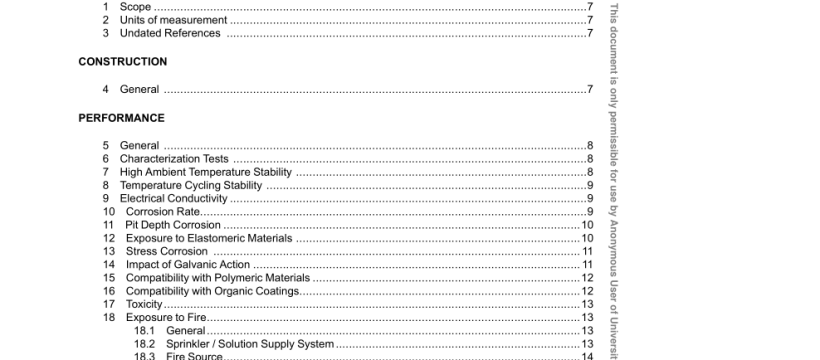UL 2901-2019 pdf download.Antifreeze Solutions for Use in Fire Sprinkler Systems.
1 Scope 1.1 This standard covers requirements for the performance of antifreeze solutions for fire sprinkler systems. 1.2 These solutions are intended for use in wet pipe sprinkler systems subject to freezing for installation in accordance with the manufacturer’s design and installation instructions, Standard for the Installation of Sprinkler Systems in One- and Two-Family Dwellings and Manufactured Homes, NFPA 13D, Standard for the Installation of Sprinkler Systems in Low-Rise Residential Occupancies, NFPA 13R, and the Standard for Installation of Automatic Sprinkler Systems, NFPA 13; and inspected, tested and maintained in accordance with the Standard for Inspection, Testing and Maintenance of Water Based Fire Protection Systems, NFPA 25. 1.3 This standard does not contain requirements to evaluate the risk associated with products of combustion of antifreeze solutions. 2 Units of measurement 2.1 The unit designated in each requirement shall be used as the official unit for purposes of that specific test in this standard. Where values of measurement are specified in both SI and English units, the unit in parenthesis is for information only. 3 Undated References 3.1 Any undated reference to a code or standard appearing in the requirements of this standard shall be interpreted as referring to the latest edition of that code or standard.
8 Temperature Cycling Stability 8.1 An antifreeze solution shall maintain stability and not separate after being exposed to a temperature cycling between intended use temperature extremes after 40 cycles. The solution characteristics after exposure shall meet the following requirements: a) A change of not more than 10% in viscosity and specific gravity b) A change of not more than 6°C (11°F) in Pour Point c) A change of not more than 3°C (5.4°F) in Freeze Point d) A change of not more than 1 pH unit 8.2 For each concentration of antifreeze solution, at least two covered containers having a volume not less than 0.5 liters are to be filled 90% full ± 2% (10% headspace) with the antifreeze solution and placed in a temperature conditioned chamber capable of exposing the samples to temperature limitations for the concentrations indicated in the manufacturer’s installation instructions. As indicated in 4.5, the maximum use temperature is not to be less than 150 °F (66 °C). The samples are to be cycled from the minimum to the maximum intended use temperatures once each 24 h for a total of 40 cycles. 8.3 After the exposure the sample solutions are to be subjected to the tests specified in Table 6.1. 9 Electrical Conductivity 9.1 The electrical conductivity of an antifreeze solution shall not exceed 7000 µSiemens/cm when tested in accordance with 9.2. 9.2 Each formulation and concentration of antifreeze solution shall be subjected to the conductivity test in accordance with ASTM D1125, Standard Test Methods for Electrical Conductivity and Resistivity of Water.
15 Compatibility with Polymeric Materials 15.1 Antifreeze solutions intended for use with specific polymeric materials referenced in the manufacturer’s installation instructions shall not cause the material tensile strength of the polymeric material to be reduced by more than 30 percent when tested in accordance with 15.3 through 15.5. 15.2 In addition to 15.1, chlorinated polyvinyl chloride (CPVC) and cross-linked polyethylene (PEX) piping materials shall comply with 28.2 of the Standard for Thermoplastic Sprinkler Pipe and Fittings for Fire Protection Service, UL 1821, when tested for 1000 h, pressurizing the piping with each concentration of antifreeze solution rather than water. 15.3 Tensile strength specimens of each polymeric material being tested are to be prepared in accordance with the Standard for the Test Method for the Tensile Properties of Plastics, ASTM D638. 15.4 The polymeric tensile strength specimens are to be immersed in the antifreeze solution and maintained at a temperature of 189 ±4°F (87 ±2°C) for 90 days. 15.5 After the exposure, the tensile strength test specimens are to be conditioned for at least 24 h at 70 ±5° F (21 ±3° C) and 50 percent relative humidity prior to tensile testing. After this conditioning, tensile strength testing shall be conducted in accordance with ASTM D638 using a crosshead speed applicable to the materials being tested.UL 2901-2019 pdf download.
UL 2901-2019 pdf download
